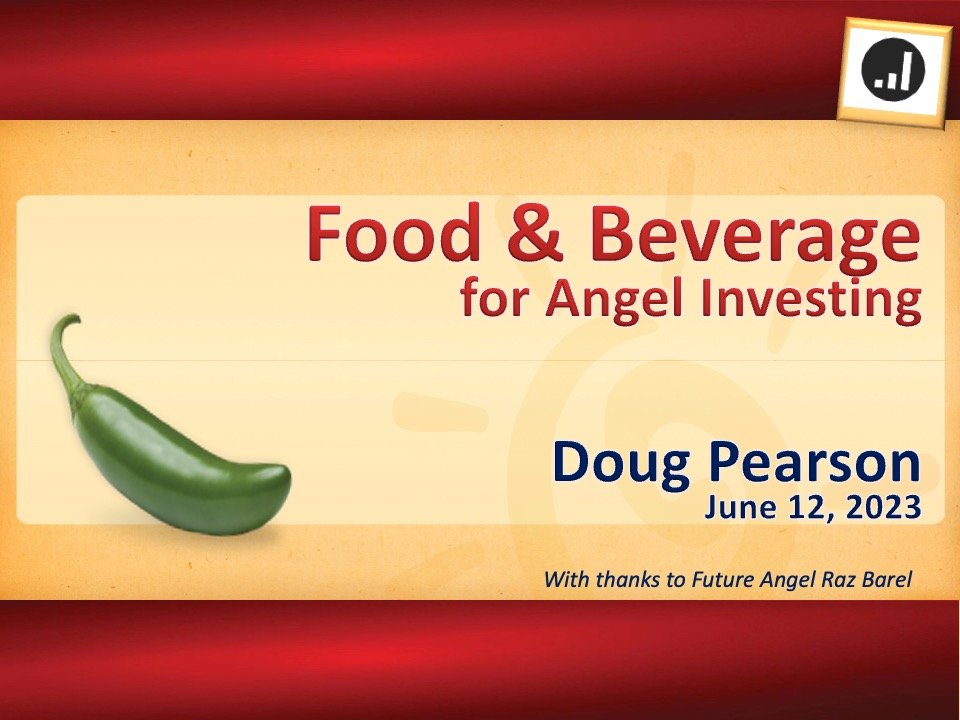FOOD & BEVERAGE FOR ANGEL INVESTING
Photo by Franki Chamaki on Unsplash
During our Investment Forum meeting on June 12th, member Doug Pearson gave a compelling presentation on investing in Food and Beverage companies. Having had a career in CPG, encompassing P&G and Sabra, Doug is now a Board member and an early-stage investor focused on CPG, AgTech and FoodTech opportunities.
Firstly, Food and Beverage is a large sector, worth over $1 trillion in the US, which represents ~5% of GDP. Consequently, winners in this sector can get very big, very fast. This goes some way to explaining why almost 9% of all Angel financing deals are in the F&B/Agriculture sector (that’s one deal for every 11 done), and with the focus on new/healthier foods, the sector has grown 6% in the past 5 years. As an Angel investor you cannot ignore Food and Beverage.
That said, this sector is not for the feint hearted. Almost 85% of new F&B products fail within the first two years, which is somewhat above the norm for Angel investing. However, it will resonate with the investors who are looking for their investments to “fail fast”, allowing them to concentrate on maximizing their successful returns.
Those who succeed will have accomplished four things:
Product Awareness: The percentage of the target market who know about the product. This is made easier with digital marketing, but it is costly
Consumer Trial: The percentage of the target market who have actually tried the product in the in past 12 months
Repeat Customers: The number of returning customers per year. This is the most important, and hardest to achieve, of all of the metrics
Availability: Or distribution, the number of locations where product is sold, and potentially the easiest to achieve (Distributors are very happy to take your business and take little risk)
Margin is critically important for a Food & Beverage company selling via retail outlets. This is fundamentally because the retailer, distributor and co-packer each take large percentages of the consumer revenue. As an example of a product that would sell for $6 in a store, the F&B company could expect to see only $1.20 of that revenue, or 20% (see the accompanying video for a complete explanation). However, when trade promotions, slotting fees and guaranteed buy-backs are factored in, $1.20 may be a best-case scenario. Retail is a tough channel to succeed in.
But companies do succeed, and those successful company can have some of the following traits:
Companies that Manufacture their own product
Saving in the region of 10-20 gross margin points
Distribution beyond Wegman’s & Whole Foods
Who tend to be more liberal in allowing new brands onto their shelves, but they are also fast to remove under-performers
Focus on just one region (rather than lots)
Proving success in a “home” market where more can be controlled
Leave expansion spending for the Series A round
For those selling online, look for lots of good reviews
Use research (e.g. commitment at a price point), and listen to your customers
Look for the potential to go “upstream”
e.g. where someone else is taking manufacturing/supply chain risk
Finally, for any F&B investment to be “successful”, there will need to be an exit, and there have been some very high profile successes. Unfortunately, F&B companies account for less than 4% of Series A deals and 2.7% of Series B (representing a big drop off as later stage rounds focus on fewer “winners”). Also there have been very few IPOs in the last 3 years, and very few PE/strategic exits worth >$50M. This is largely because F&B companies either:
Fail fast
Are acquired early for modest gains, or
Evolve into a “lifestyle” business
So, for investors, F&B can be an interesting sector, and, with luck, can provide good returns. However, investors should rule out companies with gross margins of less than 40%, (especially ones that promise to “fix it with scale”) as there simply is not sufficient profit to create a sustaining business. Also, nearly all CPG companies will underestimate their working capital & marketing needs.
Watch highlights of the presentation here:
Doug explains why margins are the key to success in this sector
What a “good” margin is for an early-stage company
What to look for as an Angel Investor
CPG Investing For Angels



